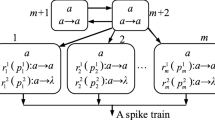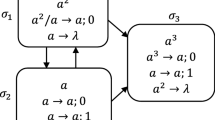Abstract
The distributed adaptive optimization spiking neural P systems (DAOSNPS) are membrane optimization algorithms which does not depend on evolutionary algorithms or swarm intelligence algorithms. It is acknowledged that population structure is very important to enhance the performance of the original optimization algorithms. In this paper, a proper migration strategy including dynamic migration interval is proposed to boost the performance of DAOSNPS. More specifically, first of all, the dynamic migration interval is introduced to speed up the convergence. Furthermore, the number of subpopulations and the migration size are discussed to select the appropriate number of subpopulations and the migration size to balance the exploration and exploitation ability. Finally, two strategies of migration individual selection and replacement individual selection are analyzed and compared in DAOSNPS. The extensive experimental results on the 0/1 knapsack problem show that DAOSNPS with the dynamic migration interval can effectively decrease time consumption. The appropriate migration strategy can obtain better balance in terms of the quality of convergence and diversity.

















Similar content being viewed by others
References
Pan, L., Păun, G., & Zhang, G. (2019). Foreword: Starting JMC. Journal of Membrane Computing, 1(1), 1–2.
Zhang, G. (2021). Membrane computing. International Journal of Parallel, Emergent and Distributed Systems, 36(1), 1–2.
Zhang, G., Pérez-Jiménez, M. J., & Gheorghe, M. (2017). Real-life applications with membrane computing. Springer.
Zhang, G., Shang, Z., Verlan, S., Martínez-Amor, M., Yuan, C., Valencia-Cabrer, L., & Pérez-Jiménez, M. J. (2020). An overview of hardware implementation of membrane computing models. ACM Computing Surveys, 53(4), 1–38.
Rong, H., Duan, Y., & Zhang, G. (2022). A bibliometric analysis of membrane computing (1998–2019). Journal of Membrane Computing, 4(2), 177–207.
Păun, G. (2000). Computing with membranes. Journal of Computer and System Sciences, 61(1), 108–143.
Pan, L., & Zhang, G. (2010). A survey of membrane computing as a new branch of natural computing. Chinese Journal of Computers, 33(2), 1–9.
Manca, V., & Bianco, L. (2008). Biological networks in metabolic P systems. Bio Systems, 91(3), 489–498.
Frisco, P., & Gheorghe, M. (2013). Applications of membrane computing in systems and synthetic biology. Springer.
Ciobanu, G., Pérez-Jiménez, M. J., & Păun, G. (2006). Applications of membrane computing. Springer.
Wang, X., Zhang, G., Gou, X., Paul, P., Neri, F., Rong, H., Yang, Q., & Zhang, H. (2021). Multi-behaviors coordination controller design with enzymatic numerical P systems for robots. Integrated Computer Aided Engineering, 28(2), 119–140.
Li, B., Peng, H., & Wang, J. (2021). A novel fusion method based on dynamic threshold neural P systems and nonsubsampled contourlet transform for multi-modality medical images. Signal Processing the Official Publication of the European Association for Signal Processing, 178, 107793.
Zhang, G., Rong, H., Neri, F., & Pérez-Jiménez, M. J. (2014). An optimization spiking neural P system for approximately solving combinatorial optimization problems. International Journal of Neural Systems, 24(05), 1440006.
Zhu, M., Yang, Q., Dong, J., Zhang, G., & Neri, F. (2021). An adaptive optimization spiking neural P system for binary problems. International Journal of Neural Systems, 31(1), 2050054.
Dong, J., Zhang, G., Luo, B., Yang, Q., Guo, D., Rong, H., Zhu, M., & Zhou, K. (2022). A distributed adaptive optimization spiking neural P system for approximately solving combinatorial optimization problems. Information Sciences, 596(1), 1–14.
Wang, T., Zhang, G. X., Zhao, J. B., He, Z. Y., Wang, J., & Pérez-Jiménez, M. J. (2015). Fault diagnosis of electric power systems based on fuzzy reasoning spiking neural P systems. IEEE Transactions on Power Systems, 30(3), 1182–1194.
Wu, T., Pan, L., Yu, Q., & Tan, K. (2020). Numerical spiking neural P systems. IEEE Transactions on Neural Networks and Learning Systems, 32(6), 1–15.
Păun, A., & Păun, G. (2002). The power of communication: P systems with symport/antiport. New Generation Computing, 20(3), 295–305.
Pan, L., Păun, G., & Pérez-Jiménez, M. J. (2011). Spiking neural P systems with neuron division and budding. Science China Information Sciences, 54(8), 1596–1607.
Pan, L., Zhang, Z., Wu, T., & Xu, J. (2017). Numerical P systems with production thresholds. Theoretical Computer Science, 673, 30–41.
Pan, L., Orellana-Martín, D., Song, B., & Pérez-Jiménez, M. J. (2019). Cell-like P systems with polarizations and minimal rules. Theoretical Computer Science, 816, 1–18.
Freund, R., Păun, G., & Pérez-Jiménez, M. J. (2005). Tissue P systems with channel states. Theoretical Computer Science, 330(1), 101–116.
Song, B., Zhang, C., & Pan, L. (2017). Tissue-like P systems with evolutional symport/antiport rules. Information Sciences: An International Journal, 378, 177–193.
Zhang, G., Zhang, X., Rong, H., Paul, P., Zhu, M., Neri, F., & Ong, Y. (2022). A layered spiking neural system for classification problems. International Journal of Neural Systems, 32(8), 2250023.
Zhang, G., Pérez-Jiménez, M. J., Riscos-Núñez, A., Verlan, S., Konur, S., Hinze, T., & Gheorghe, M. (2021). Membrane computing models: Implementations. Springer.
Zhang, G., Rong, H., Paul, P., He, Y., Neri, F., & Pérez-Jiménez, M. J. (2021). A complete arithmetic calculator constructed from spiking neural p systems and its application to information fusion. International Journal of Neural Systems, 31(1), 2050055.
Zhang, G., Cheng, J., Gheorghe, M., & Meng, Q. (2013). A hybrid approach based on differential evolution and tissue membrane systems for solving constrained manufacturing parameter optimization problems. Applied Soft Computing, 13(3), 1528–1542.
Zhang, G., Gheorghe, M., & Wu, C. (2008). A quantum-inspired evolutionary algorithm based on P systems for knapsack problem. Fundamenta Informaticae, 87(1), 93–116.
Weber, M., Tirronen, V., & Neri, F. (2010). Scale factor inheritance mechanism in distributed differential evolution. Soft Computing, 14(11), 1187–1207.
Weber, M., Neri, F., & Tirronen, V. (2013). A study on scale factor/crossover interaction in distributed differential evolution. Artificial Intelligence Review, 39(3), 195–224.
Cheng, J., Zhang, G., & Neri, F. (2013). Enhancing distributed differential evolution with multicultural migration for global numerical optimization. Information Sciences, 247(1), 72–93.
Yang, S., & Tinós, R. (2007). A hybrid immigrants scheme for genetic algorithms in dynamic environments. International Journal of Automation and Computing, 4(3), 243–254.
Zaharie, D., & Petcu, D. (2003). Parallel implementation of multi-population differential evolution. In Proceedings of the 2nd workshop on concurrent information processing and computing (pp. 223–232).
Apolloni, J., Leguizamon, G., García-Nieto, J., & Alba, E. (2008). Island based distributed differential evolution: An experimental study on hybrid test beds. In Proceedings of the 8th international conference on hybrid intelligent systems (pp. 696–701).
Cantú-Paz, E. (2001). Migration policies, selection pressure, and parallel evolutionary algorithms. Journal of Heuristics, 7(4), 311–344.
Araujo, L., & Merelo, J. (2011). Diversity through multiculturality: Assessing migrant choice policies in an island model. IEEE Transactions on Evolutionary Computation, 15(4), 456–469.
Weber, M., Neri, F., & Tirronen, V. (2010). Island based distributed differential evolution: an experimental study on hybrid test beds. Applications of evolutionary computing, EvoWorkshops, lecture notes in computer science (Vol. 6024, pp. 471–480). Springer.
Mc Ginley, B., Maher, J., O’Riordan, C., & Morgan, F. (2011). Maintaining healthy population diversity using adaptive crossover, mutation, and selection. IEEE Transactions on Evolutionary Computation, 15(5), 692–714.
Han, K., & Kim, J. (2002). Quantum-inspired evolutionary algorithm for a class of combinatorial optimization. IEEE Transactions on Evolutionary Computation, 6(6), 580–593.
Zhang, G., Gheorghe, M., & Li, Y. (2012). A membrane algorithm with quantum-inspired subalgorithms and its application to image processing. Natural Computing, 11(4), 701–717.
Zhang, G. (2011). Quantum-inspired evolutionary algorithms: A survey and empirical study. Journal of Heuristics, 17(3), 303–351.
Acknowledgements
This work was supported by the National Natural Science Foundation of China (61972324, 61672437, 61702428), the Sichuan Science and Technology Program (2021YFS0313, 2021YFG0133, 2021YJ0086, 2022YFG0181, 23NSFTD0049, 23ZDYF0247), and Chengdu Technological Innovation Development Project (2022-YF05-01134-SN).
Author information
Authors and Affiliations
Corresponding author
Ethics declarations
Conflict of interest
On behalf of all authors, the corresponding author states that there is no conflict of interest
Additional information
Publisher's Note
Springer Nature remains neutral with regard to jurisdictional claims in published maps and institutional affiliations.
Rights and permissions
Springer Nature or its licensor (e.g. a society or other partner) holds exclusive rights to this article under a publishing agreement with the author(s) or other rightsholder(s); author self-archiving of the accepted manuscript version of this article is solely governed by the terms of such publishing agreement and applicable law.
About this article
Cite this article
Dong, J., Zhang, G., Xiao, D. et al. Migration strategy in distributed adaptive optimization spiking neural P systems. J Membr Comput 4, 314–328 (2022). https://doi.org/10.1007/s41965-022-00117-2
Received:
Accepted:
Published:
Issue Date:
DOI: https://doi.org/10.1007/s41965-022-00117-2




